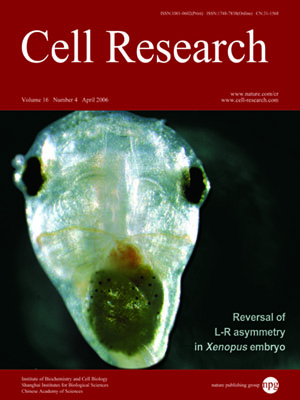
Volume 16, No 4, Apr 2006
ISSN: 1001-0602
EISSN: 1748-7838 2018
impact factor 17.848*
(Clarivate Analytics, 2019)
Volume 16 Issue 4, April 2006: 377-388
ORIGINAL ARTICLES
Identification of AtENT3 as the main transporter for uridine uptake in Arabidopsis roots
Kun Ling Chen, Min Xin Xu, Guang Yong Li, Hui Liang, Zong Liang Xia, Xin Liu, Ji Shu Zhang, Ai Min Zhang, Dao Wen Wang
School of Life Sciences, Northwest Agricultural and Forestry University, Yangling 712100, China; Center for Plant Gene Research (Beijing) and the State Key Laboratory of Plant Cell and Chromosome Engineering, Institute of Genetics and Developmental Biology, Chinese Academy of Sciences, Datun Road, Chaoyang District, Beijing 100101, China; 3Graduate School of the Chinese Academy of Sciences, Yuquan Road, Shijingshan District, Beijing 100039, China
Correspondence: Dao Wen Wang(dwwang@genetics.ac.cn)
Previous studies have shown that Arabidopsis equilibrative nucleoside transporters (AtENTs) possess transport activities when produced in yeast cells and are differentially expressed in Arabidopsis organs. Herein, we report further analysis on the nucleoside transport activities and transcriptional patterns of AtENT members. The recombinant proteins of AtENTs 3, 6, and 7, but not those of AtENTs 1, 2, 4, and 8, were found to transport thymidine with high affinity. Contrary to previous suggestion that AtENT1 may not transport uridine, this work showed that recombinant AtENT1 was a pH-dependent and high-affinity transporter of uridine. When grown on MS plates, the AtENT3 knockout plants were more tolerant to the cytotoxic uridine analog 5-fluorouridine than wild-type plants and the knockout plants of AtENT1 or AtENT6. Consistent with this observation, the AtENT3 knockout line exhibited a significantly decreased ability to take up [3H]uridine via the roots when compared with wild-type plants and the plants with mutated AtENT1 or AtENT6. This indicates that AtENT3, but not AtENTs 1 and 6, is the main transporter for uridine uptake in Arabidopsis roots. The transcription of AtENTs 1, 3, 4, 6, 7, and 8 was regulated in a complex manner during leaf development and senescence. In contrast, the six AtENT members were coordinately induced during seed germination. This work provides new information on the transport properties of recombinant AtENT proteins and new clues for future studies of the in vivo transport activities and physiological functions of the different ENT proteins in Arabidopsis plants.
Cell Research (2006) 16:267-276. doi:383-394. doi:10.1038/sj.cr.7310049; published online 13 April 2006
FULL TEXT | PDF
Browse 1959


